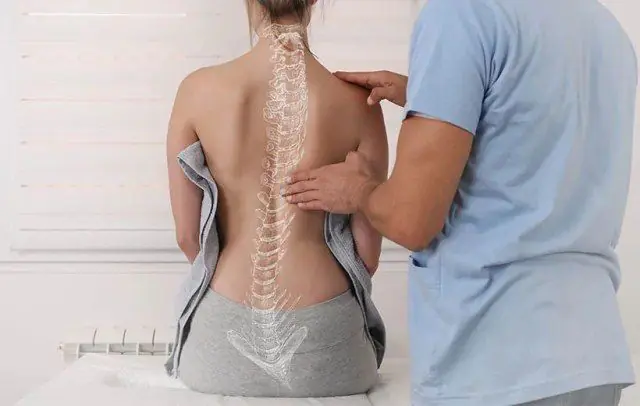
The main causes of spondylosis, symptoms of the disease. Methods for diagnosing and treating the disease, prevention.
The content of the article:- Reasons for development
- Symptoms of spondylosis
- Treatment options
- Medicines
- Folk remedies
- Physiotherapy
- Surgery
- Prevention
Spondylosis is a disease in which bone tissue grows along the edge of the vertebrae. It is dangerous for the processes to grow together, which leads to complete immobilization of these parts of the spine. It most often occurs in older people, but can also be diagnosed in children as a congenital pathology of the musculoskeletal system.
Causes of spondylosis development

Pathological processes of the spine
Spondylosis is classified as a degenerative dystrophic chronic process, expressed in the pathological growth of vertebral bone tissue. These growths look like processes and are called “osteophytes.” This is a serious disease, dangerous because at the initial stage the formation of these processes occurs asymptomatically, and later, with anatomical changes in the vertebrae, it is accompanied by very strong pain and significantly limits the mobility of the spine - this is the main reason why spondylosis is dangerous.
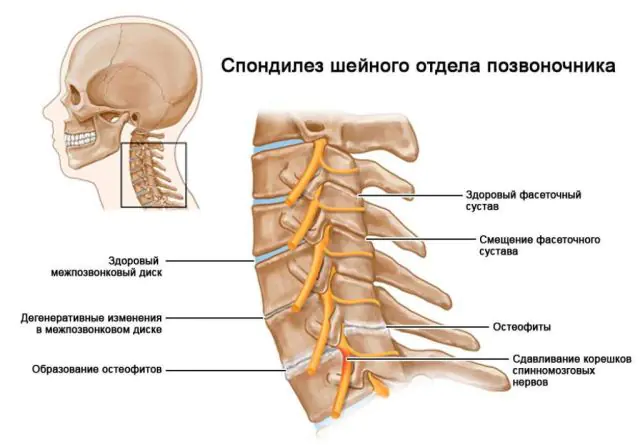
Depending on the location, there are several types of disease: cervical, thoracic and lumbar.
Spondylosis is divided according to degrees of development:
- First stage. The bone formations grow only slightly beyond the vertebrae.
- Second stage. Osteophytes from different vertebrae begin to grow towards each other.
- Third stage. The processes grow together, which leads to immobility of the vertebrae in this section.

The main reasons for the development of spondylosis:
- Excess body weight. Excess weight is one of the most common causes of the development of many spinal diseases, and spondylosis is no exception. This happens due to increased load on the musculoskeletal system.
- Sedentary lifestyle. This is the second most common cause of spondylosis. A decrease in muscle tone, which develops in the absence of proper physical activity, contributes to the growth of bone tissue and the formation of osteophytes.
- Excessive exercise. Not only a lack of physical activity, but also an excess of physical activity can negatively affect the functioning of the spine. Everything is good in moderation.
- Metabolic disorders. Good metabolism is one of the most important conditions for the full functioning of all systems and organs, and the musculoskeletal system needs this no less than any other. It is not enough to obtain useful components for the formation of a strong skeleton; it is important that these components are also absorbed.
- Avitaminosis. And if, along with poor metabolism, you also have vitamin deficiency, then disturbances in the functioning of the musculoskeletal system cannot be avoided.
- Injuries. Injury, as well as inflammatory processes of muscle tissue in the spine provoke the formation of osteophytes.
- Age-related changes. With age, the body's ability to produce osteophytic growths sharply increases, since several of the above reasons for the development of the disease often occur at once.
- Congenital pathology. There are cases where babies were born with this disease.
Main symptoms of spondylosis
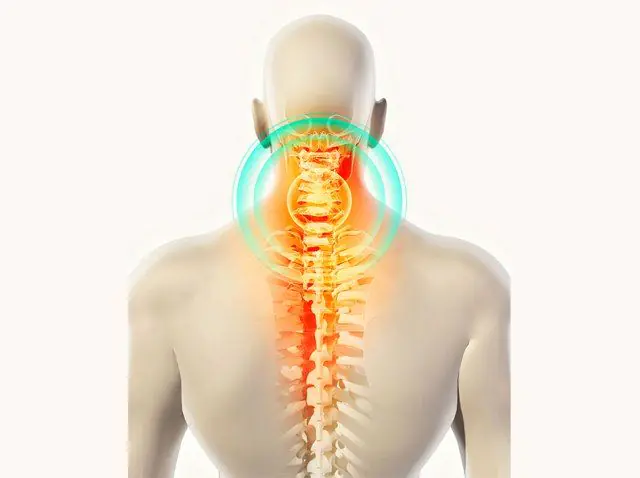
As already noted, the insidiousness of this disease lies in the fact that at the very beginning of its development it does not have pronounced symptoms. The patient may not even realize that he is sick, while early detection of the disease allows one to avoid surgical intervention.
The main symptoms of spondylosis:
- Pain syndrome. Depending on the location of the osteophytes, pain can be reflected in the limbs, neck, and head.
- Decreased mobility. It seems as if your neck, chest or lower back are “clinging”. There is no way to turn to the side, and efforts cause acute pain.
- Muscle tension. Sometimes it even ends in a convulsive state.
It is worth noting that the main manifestation of spondylosis is pain. In the early stages it is barely noticeable. Then it develops into aching. And when the disease has developed sufficiently strongly, it becomes acute.
Associated manifestations of spondylosis:
- Irritation of the spinal nerve roots;
- Vasospasm;
- Metabolic disorder of intervertebral discs;
- Hernia formation;
- Sensitivity disorder.
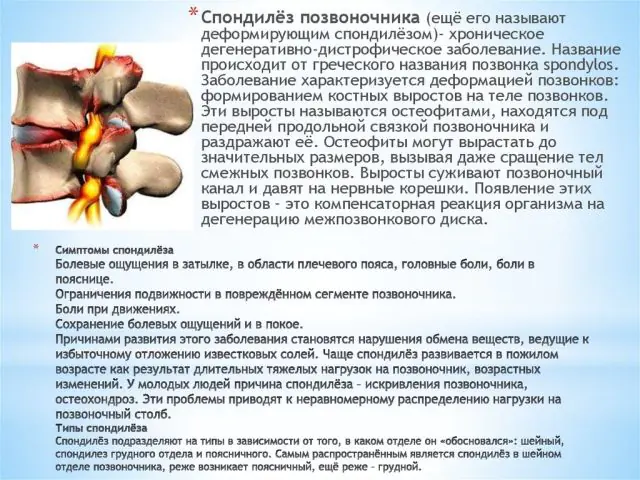
It is important to carry out timely and correct diagnosis of the disease. Consultation with an orthopedist and neurologist is necessary, as well as computed tomography or magnetic resonance imaging. Based on the data obtained, the attending physician will decide on the prescription of therapy and the initiation of treatment for spondylosis.
Methods for treating spondylosis
There are several types of treatment: medication, the use of folk remedies and physical therapy, as well as surgery. The first stage of the disease can be cured without surgery. In the second and third cases, only a radical method will help for a complete cure; others will only put spondylosis into remission.
Medicines for the treatment of spondylosis

Body balms with capsaicin for spondylosis
Several groups of drugs are used in the treatment of spondylosis. In particular, doctors actively prescribe non-steroidal anti-inflammatory drugs, analgesics and muscle relaxants.
Non-steroidal anti-inflammatory drugs are drugs designed to relieve pain, reduce fever and reduce inflammation. The name “non-steroidal” indicates their difference from glucocorticoids. In other words, they do not have the negative properties of steroids.
This group includes the following products:
- Ibuprofen. Suppresses the production of substances responsible for pain and inflammation. For short-term use, the tablet should be swallowed whole and washed down with plenty of water. It is important to use the lowest effective dose. Price - from 31 rubles in Russia (from 22 hryvnia in Ukraine) for 50 tablets of 200 mg.
- Nalgesin. The drug effectively eliminates the inflammatory process, reduces body temperature and relieves pain. The tablets are taken orally, after meals, with water. Price - from 191 rubles in Russia (from 48 hryvnia in Ukraine) for 10 tablets of 275 mg.
Painkillers or analgesics reduce the pain effect, but do not affect inflammatory processes in the human body. The advantage of analgesics over non-steroidal anti-inflammatory drugs is a lower risk of side effects. However, since spondylosis cannot be treated with these drugs alone, they should be used as few times as possible.
Analgesics for the treatment of spondylosis:
- Body balms with capsaicin. They cause a warming effect and reduce the sensitivity of skin pain receptors. Price - from 200 rubles in Russia (from 195 hryvnia in Ukraine) for 75 ml.
- Codeine-containing drugs. The analgesic effect is achieved through narcotic stimulation of certain receptors in various parts of the central nervous system and peripheral tissues, which leads to a change in the emotional perception of pain. Since the drug is classified as a narcotic, it is used only as prescribed by a doctor and is not commercially available.
Muscle relaxants are medications that help relax muscles in the human body. For spondylosis, they help relieve spasms, pain and reduce inflammation. Also used in the surgical treatment of spondylosis.
Effective muscle relaxants against spondylosis:
- Spasmalgon. Pitophenone hydrochloride and fenpiverinium bromide, which are part of the drug, directly affect the smooth muscles of the internal organs and cause a relaxing effect. Take from half to 2 tablets, depending on age, 2-3 times a day. The drug should be taken after meals and washed down with plenty of water. Price - from 135 rubles in Russia (from 34 hryvnia in Ukraine) for 10 tablets.
- Mydocalm. Centrally acting muscle relaxant. Inhibits the conduction of impulses, has a membrane-stabilizing effect and a local anesthesia effect. Use strictly as prescribed by the doctor. In most cases, adults are prescribed 1 tablet (150 mg) 3 times a day. Price - from 375 rubles in Russia (from 192 hryvnia in Ukraine) for 30 tablets of 150 mg.
Folk remedies against spondylosis

Red elderberry juice for spondylosis
Traditional medicine recipes are often used to treat spondylosis. Patients note that these methods are especially effective when combined with physical therapy. However, as is known, medicinal herbs have quite a lot of indications, contraindications and side effects. Therefore, it is extremely important to coordinate all actions with your doctor based on your medical history and the presence of other chronic diseases. Otherwise, alternative treatment for spondylosis may do more harm to the body than good.
Traditional medicine recipes against spondylosis:
- Herbal collection. The leaves of burdock, St. John's wort, nettle, juniper, peppermint, parsley and dandelion root, sage and fennel have proven themselves well in the treatment of this disease. Decoctions of these herbs help relieve pain, relieve inflammation, normalize metabolism and restore healthy processes in cartilage and bone tissue. Take 1 tablespoon of herbs and brew 0.5 liters of water. Leave in a thermos for at least 8 hours. Then strain and drink 100 ml, in between meals, 3-4 times a day. The course of treatment is at least 2 months. Then you need to take a 10-day break and take the course again. To achieve a good result, at least 10 courses are required.
- Red elderberry juice. Start treatment with this method as soon as you notice the first signs of spondylosis. Soak a piece of folded gauze or a cotton pad in freshly squeezed red elderberry juice and apply to the affected area. The compress should remain on the body for at least 20 minutes. Frequency of use: at least twice a day. It is also allowed to use juice not only for compresses, but also for rubbing. In addition to spondylosis, this recipe is also effective in the treatment of joints, osteochondrosis, arthritis and arthrosis.
- Horsetail juice. Wintering horsetail contains a lot of zinc, iron and silicon. This increases the mobility of the vertebrae, relieves inflammation, relieves pain in cases of rheumatism and helps in the treatment of spondylosis. It should be taken half an hour before meals, three times a day, 20-30 drops. Please note that treatment of spondylosis with this folk remedy is contraindicated in case of kidney disease, especially at the acute stage.
- Comfrey root. In this case, an extract from the root of the plant is used. It cannot be prepared at home, so it is recommended to purchase it at a pharmacy or from herbalists. The components of the root help relieve inflammation, have an analgesic effect, promote wound healing and tissue regeneration. It should be taken immediately before meals, at least three times a day, 30-35 drops. You can also rub the extract into the affected area or make compresses from the medicinal liquid.
Physical therapy for spondylosis
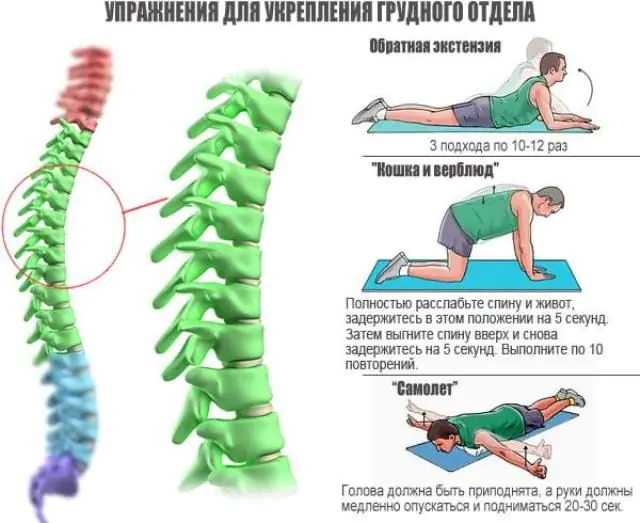
When treating spondylosis with folk remedies, doctors recommend enhancing the effect of medicinal plants with special physical training. It helps to relax the muscles that support the skeletal system, relieve inflammation, and reduce pain.
Exercises for spondylosis:
- Stand up straight. Lower your shoulders down and move them back a little. Slowly tilt your head forward until your chin touches your chest. Then slowly raise your head to the starting position and tilt it back a little. Do the exercise with complete relaxation, without straining.
- Place your hands on your hips and in this position try to bring your shoulder blades together and apart. Repeat these movements 5-7 times, then lower your arms down, as if releasing tension, and repeat the spread-out again. In total you need to do at least 5 approaches.
- With your arms in front of you and your feet shoulder-width apart, bend forward several times slowly. Then increase your speed and gradually incline as quickly as possible. In one approach you need to do about 15-20 bends. This exercise has worked well both at the initial stage of spondylosis and in advanced cases.
- Raise your arms up while taking a deep breath. Freeze in this position for a second, then stretch and exhale completely as you lower your arms.
- Stand straight, place your feet shoulder-width apart. Slowly raise your shoulders up and down. When moving up, inhale, while moving down, exhale.
- Sit on a chair with your elbows on the back. Place your hands behind your head, inhale and bend back, then slowly lower your hands.
- Stand up straight, place your hands on your waist. Lean to the left, throwing your right arm up, then lean to the right, throwing your left arm up.
Surgery for spondylosis

As already noted, in the later stages of spondylosis, only surgical intervention can lead to a complete cure. However, despite this, patients extremely rarely resort to this method of treatment. First, the doctors themselves try to try the entire arsenal of drugs that can cause a stable long-term remission in the patient. In the event of an exacerbation of the disease, therapy is again used, aimed at relieving symptoms that significantly worsen the quality of life.
For spondylosis, surgery is prescribed, as a rule, when the disease has led to the formation of associated diseases, for example, intervertebral hernia, and here the question arises that such a condition can cause permanent verticalization of the patient.
Preparation for the procedure includes:
- Examination by narrow specialists;
- Taking biochemical blood and urine tests;
- Taking a CT or MRI scan of the spine;
- Transferring any chronic diseases into remission;
- Neutralization of carious lesions in the oral cavity.
Excision of osteophytes is carried out using both traditional surgical and laser methods. The operation requires hospitalization and postoperative recovery, which may take about a month.
Methods for preventing spondylosis
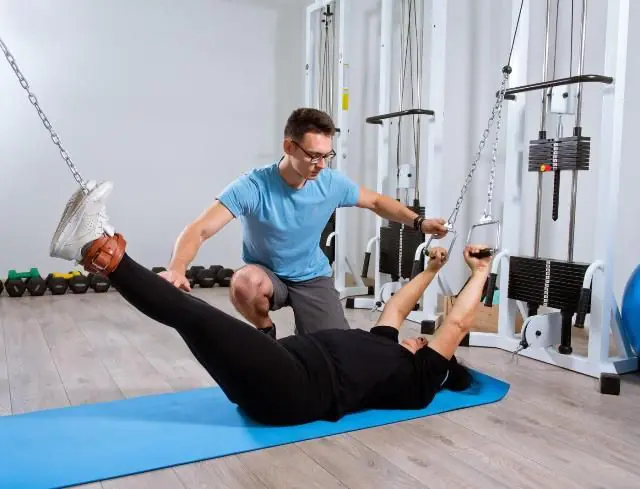
Like any disease, spondylosis is easier to prevent than to cure. And it is worth noting that to prevent the development of the disease you do not need to make great efforts.
Measures to prevent manifestations of spondylosis:
- Moderate physical activity. Even if we are talking about elderly people, constant bed rest negatively affects the entire body, and for the spine it becomes the cause of the development of irreversible processes. Therefore, if there is no desire to rise, you need to do it through force. This is the only way to prevent the development of osteophytes.
- No surges. Excessive exercise can also cause bone overgrowth. Therefore, when choosing a profession or fighting for summer harvests, remember what this entails.
- Regular walks and exercise. Of course, it would be very good to engage in at least some kind of sport. But if you don’t have enough time or motivation, don’t neglect walks before bed and do gymnastics once a day, which is indicated for spondylosis.
- Eat well. If you feel that you cannot fully provide your body with nutritious food or your metabolism is impaired, use vitamin complexes.
How to treat spondylosis - watch the video:
At the first signs of the disease, it is extremely important to undergo diagnosis and begin therapy. This will help avoid complications of spondylosis, the inevitable result of which will be spinal surgery - an unpleasant, costly procedure that requires a long recovery.



